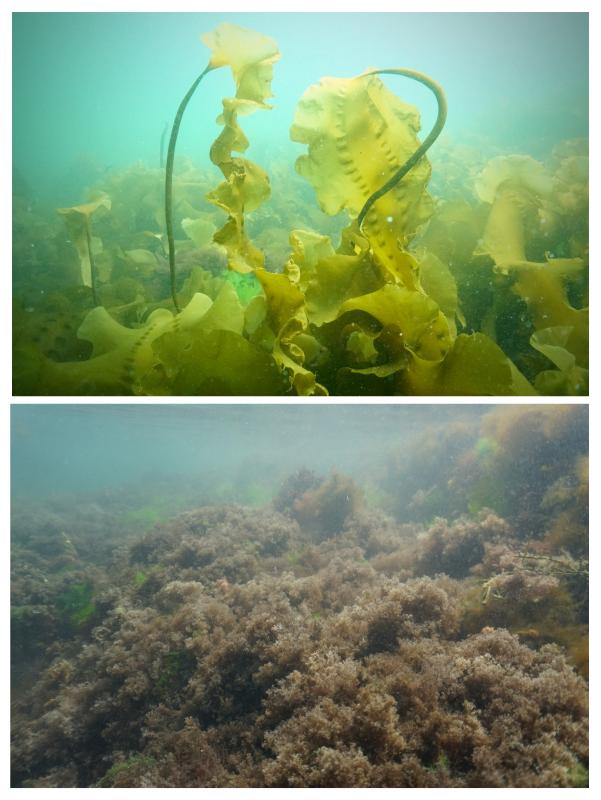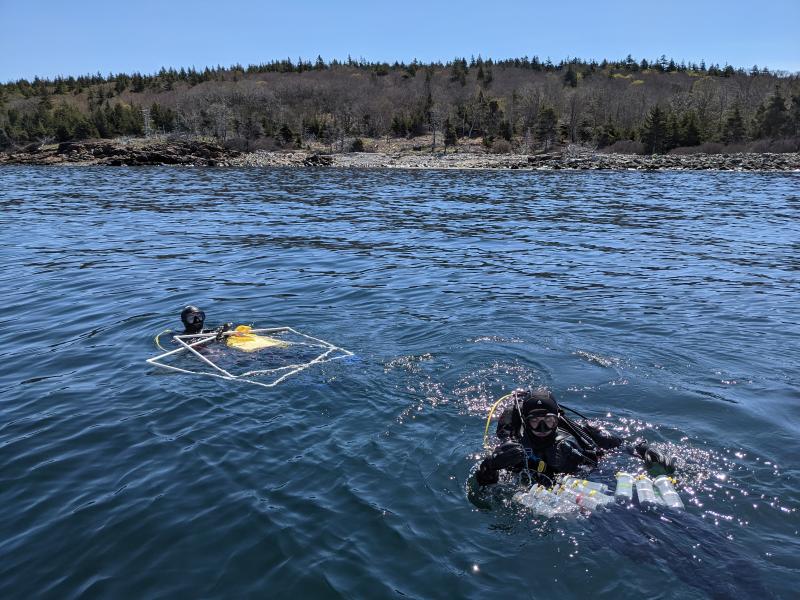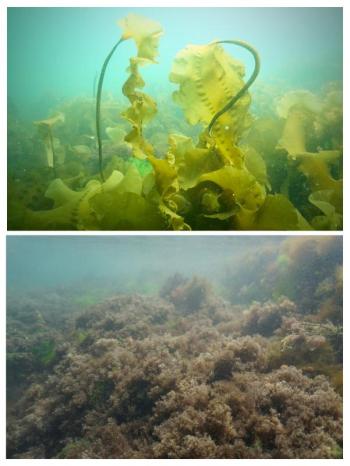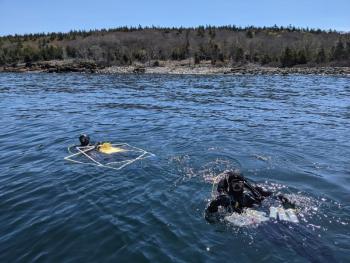Study reveals how chemical competition threatens Maine kelp forests
 Dive images show the habitat differences between a kelp-dominated reef (top) and a turf-dominated reef (bottom). Courtesy of Shane Farrell
Dive images show the habitat differences between a kelp-dominated reef (top) and a turf-dominated reef (bottom). Courtesy of Shane Farrell
 The study’s lead author, Shane Farrell, examines algae samples in the lab. Farrell spent several months on a research visit with co-author Daniel Petras at University of Tübingen in Germany. Courtesy of Bigelow Laboratory for Ocean Sciences
The study’s lead author, Shane Farrell, examines algae samples in the lab. Farrell spent several months on a research visit with co-author Daniel Petras at University of Tübingen in Germany. Courtesy of Bigelow Laboratory for Ocean Sciences
 UMaine PhD researchers Shane Farrell and Dara Yiu dive off Allen Island. Rene Francolini photo
UMaine PhD researchers Shane Farrell and Dara Yiu dive off Allen Island. Rene Francolini photo
 Dive images show the habitat differences between a kelp-dominated reef (top) and a turf-dominated reef (bottom). Courtesy of Shane Farrell
Dive images show the habitat differences between a kelp-dominated reef (top) and a turf-dominated reef (bottom). Courtesy of Shane Farrell
 The study’s lead author, Shane Farrell, examines algae samples in the lab. Farrell spent several months on a research visit with co-author Daniel Petras at University of Tübingen in Germany. Courtesy of Bigelow Laboratory for Ocean Sciences
The study’s lead author, Shane Farrell, examines algae samples in the lab. Farrell spent several months on a research visit with co-author Daniel Petras at University of Tübingen in Germany. Courtesy of Bigelow Laboratory for Ocean Sciences
 UMaine PhD researchers Shane Farrell and Dara Yiu dive off Allen Island. Rene Francolini photo
UMaine PhD researchers Shane Farrell and Dara Yiu dive off Allen Island. Rene Francolini photo
When scientist Shane Farrell went to survey ocean ecology around Damariscove Island off Boothbay over five years ago, he saw rich kelp forests covering most of the seafloor. The algae's leaf-like structure provided food and shelter as part of a thriving ecological web. Over the course of his years-long research, he watched as the kelp forest almost completely disappeared. The island is only one of several examples across the Gulf of Maine.
“It's hard to wrap your head around it,” said Farrell, a UMaine PhD student who works at Bigelow Laboratory. "We survey the same sites twice a year, year after year. We did this for multiple years. And you would be shocked when after the first year of surveying there was a kelp forest, and then the second year you go, and it's just completely gone. It's hard to comprehend the scale of the change and how fast it's happening.”
He said kelp forest loss is driven by warming waters in the Gulf of Maine due to climate change. Farrell and his colleagues discovered that competing algae plays a significant role. As kelp forests collapse, low-lying, filamentous turf algae are taking over using what researchers say is "chemical warfare" to help.
Farrell is the lead author of a paper published in May by the journal Science that shows, for the first time, how around 30 species of turf algae release chemicals that can kill young kelp, restrict kelp growth and prepare the ecosystem for a takeover. It's a self-perpetuating cycle as more turf algae means more harmful chemicals, reinforcing kelp forest collapse and prohibiting recovery.
From thriving to surviving
“This shift from kelp to turf is analogous to a terrestrial forest transitioning into a grassland,” Farrell said in a press release, available at https://www.bigelow.org/news/articles/2025-05-22.html
"With the loss of kelp forests, we see decreases in biodiversity, productivity, and the ecosystem services they provide to humans.”
Farrell said kelp forests thrive in cold, nutrient-rich water and have historically dominated the Gulf of Maine from New Hampshire into Canada; their tall, billowing structures create a three-dimensional underwater metropolis, lost when replaced by turf algae that thrive in warmer waters.
“When you look at the south where these kelp forests have collapsed and these turf algae have taken over, it's this almost desert of matte-like small algae that are just a few inches high,” Farrell said. "... You just look out in kind of this desert or wasteland almost.”
Kelp forests play a valuable ecological role as a refuge for juvenile fish, mobile invertebrates, and other sea life that provides both shelter and meals. So, Farrell said, they are also a biodiversity hotspot and power a food web supporting life from microbes to fish to lobsters. Physically, the structures also reduce wave energy and slow coastal erosion.
According to the publication, kelp forests also support ecosystem services, including fisheries and ecotourism, that are worth billions of dollars per year globally. In Maine, Farrell said, all kelp aquaculture gets its seed from reproductive wild kelp plants. “If there's no more wild kelp, we've lost our entire production for our growing aquaculture (industry).”
The chemistry of kelp collapse
Farell and his colleagues completed three years of field surveys across the Gulf of Maine, primarily funded through the National Science Foundation, documenting a pattern of kelp struggling to survive in the southern reaches. The team collected water and seaweed samples for chemical analysis and studied all the small molecules within the system to identify unique chemical features at both kelp- and turf algae-dominated sites.
In laboratory experiments, the researchers tested the effects of both waterborne chemicals around turf-dominated reefs and specific chemicals released by the five most abundant species of turf algae on young kelp. The experiments showed kelp survival declined up to 500% when exposed to chemicals released by turf algae; this confirmed the new chemical environment is responsible for kelp mortality.
Kelp forest collapse has been well documented in temperate ecosystems around the world. Once turf algae are established, they can inhibit kelp recovery by taking up space or harboring organisms that preferably eat young kelp. Chemical changes also play a role in locking tropical ecosystems, such as coral reefs, into a degraded state and preventing kelp recovery. However, no studies considered the chemical process in temperate kelp forests until now.
“Our study is the first to reveal that chemical warfare can underpin the rebound potential of cold-water kelp forests. And surprisingly, some of the same types of molecules we identified on turf reefs are involved in the recovery dynamics of tropical coral reefs too,” said Bigelow Laboratory’s Doug Rasher, the study’s senior author, in the press release. “It shows we have a lot to learn about chemical warfare on temperate reefs, the organisms and molecules involved, and how this process varies globally.”
The Gulf of Maine and beyond
Previous work by Rasher’s research group confirmed ocean warming is the primary driver of kelp forest decline in the Gulf of Maine. But these new findings, showing how turf algae can lock an ecosystem into a degraded state, demonstrate higher barriers to kelp forest recovery.
Farrell said the researchers saw around 12.5 miles of coastline in six sites, from around Harpswell to Machais, flip from kelp- to turf algae-dominated in three to five years. Because the Gulf of Maine is warming more rapidly than most bodies of water on the planet, he said it can act as a bellwether for other areas. However, he said kelp forests haven’t disappeared from Maine and are still thriving in some northern waters.
Farrell hopes the work will highlight the need to protect what still exists, both at a global and local level. He said better understanding can help create local management plans that protect kelp forests and stop the cycle of turf algae takeover. However, to realistically allow recovery, Farrell said people also need to tackle the underlying cause of their collapse: Warming oceans due to climate change.
“It just means that we need to, as humans, try to do everything we can to reverse ocean warming and halt or slow our carbon emissions because that's the ultimate thing that's going to slow the warming waters,” he said.






























